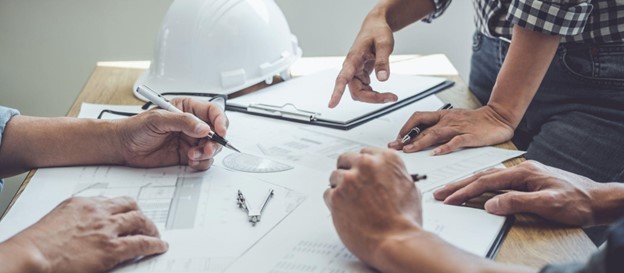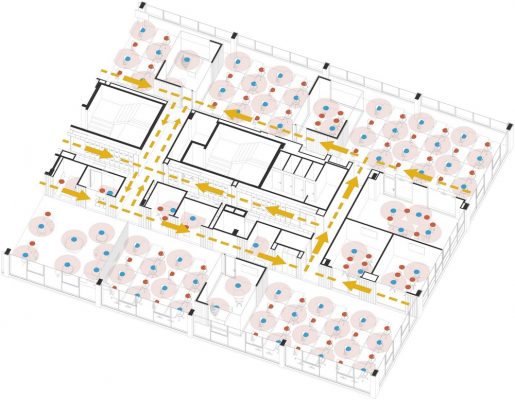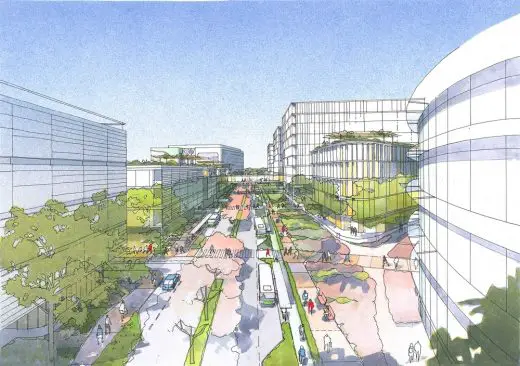COVID-19 Impact on Architecture and Design, Post-pandemic workplace guide, Remote working space design tips
The Impact of COVID-19 on Architecture and Design
8 December 2023

photo courtesy of Freedomz/Shutterstock
The COVID-19 pandemic has profoundly reshaped our lives in numerous ways. Among some of the most affected areas are architecture and design – fields inherently linked to how we interact with the spaces around us.
This article delves into how COVID-19 has influenced these fields, driving innovation, necessitating adaptation, and redefining the future of our built environment.
The Architectural Response to COVID-19
The onset of the COVID-19 pandemic brought unique challenges to the field of architecture, demanding rapid adaptation and innovation.
Modular and Rapid Construction
The pandemic’s urgency necessitated swift responses in healthcare infrastructure. A prime example is the construction of modular hospitals, such as Wuhan’s Huoshenshan Hospital, which was built in just ten days. These facilities showcased the potential of rapid construction techniques and modular design in emergency situations.
Evolution of Residential Architecture
The pandemic-induced lockdowns and the shift towards remote work and schooling led to people spending significantly more time at home. This change necessitated the transformation of homes into multifunctional spaces that could accommodate various activities.
As a result, architectural design saw a shift towards creating versatile living environments. Key integrations in new residential projects included:
- Dedicated Home Offices: Spaces specifically designed for remote work, often with enhanced soundproofing and ergonomic features.
- Learning Areas: Designated zones for online schooling, equipped with technology-friendly setups.
- Home Gyms: Incorporation of exercise areas or rooms, sometimes with built-in equipment or adaptable spaces for workouts.
- Outdoor Living Spaces: Enhanced focus on balconies, patios, or gardens to provide a natural escape within the home environment.
- Multi-Functional Furniture: Furniture designs that could serve multiple purposes, such as convertible desks or beds with storage solutions, to maximise space efficiency.
Public Spaces and Urban Planning
The pandemic brought a reimagining of urban spaces. Cities worldwide repurposed streets for pedestrian use, outdoor dining, and recreational activities. Programs like New York City’s “Open Streets” exemplify this shift towards more adaptable, community-focused urban planning.
Technological and Material Innovations
COVID-19 accelerated the adoption of technology and new materials in architecture, such as:
- Enhanced ventilation systems
- Antimicrobial materials
- Touchless technologies
These became more prevalent in public buildings, aiming to reduce the spread of the virus and improve public health safety.
Design Adaptations in the Age of a Pandemic
The design world faced the need to rapidly evolve in response to the pandemic, leading to significant changes in product, digital, and interior design.
Product Design Innovations
The pandemic sparked a surge in innovative product designs, particularly in response to health and safety needs. Some primary examples include:
- Touchless Technologies: The adoption of touchless technologies extended to a wide range of products, from automatic doors and faucets to sensor-based lighting and home appliances, reducing the need for physical contact in public and private spaces.
- Sanitation Devices: The market saw an influx of portable sanitizers, UV-C disinfection devices, and smart thermometers designed for both personal and public use.
- Air Purification Systems: Enhanced air purifiers and HVAC systems with improved filtration capabilities became popular in residential and commercial settings.
- Smart Wearables: Smart wearables like wristbands and smartwatches started incorporating features for health monitoring, including tracking vitals and alerting wearers to potential symptoms or high-risk areas.
- Home Fitness Equipment: With gyms closed, there was a surge in innovative home fitness products, from compact, multi-functional exercise machines to smart fitness accessories integrated with virtual training apps.
- Specialized Sports Masks: Companies like Under Armour developed sports masks that offered protection while ensuring breathability and comfort during physical activities.
Digital and User Experience (UX) Design
The dramatic shift to online platforms led to significant transformations in digital and UX design. For example, platforms like Zoom revamped their interfaces to accommodate a surge in users, focusing on ease of use and additional features like virtual backgrounds to enhance remote interaction.
Furniture and Interior Design
Furniture and interior design adapted to the new reality of living and working in the same space. Brands like IKEA introduced multi-functional furniture, catering to compact living spaces and the need for versatility. Minimalist and clean designs also became more popular, emphasising ease of cleaning and maintenance.
Signage and Information Design
The pandemic necessitated clear communication of health guidelines in public spaces, leading to innovative signage and information design approaches, such as:
- Informative signage
- Floor graphics
- Stickers and decals
- Digital signage
These design elements became essential in helping establishments like supermarkets and banks maintain a safe environment for customers and staff.
Broader Themes and Insights
The COVID-19 pandemic not only brought immediate changes to architecture and design but also highlighted broader themes that may shape these fields for years to come.
Sustainability and Local Production
The pandemic underscored the importance of sustainability and local production in architecture and design. In fact, supply chain statistics indicate that almost half (48%) of companies face growing pressure to implement more sustainable practices within their supply chains.
The disruption of global supply chains led to a renewed focus on sourcing materials locally and adopting eco-friendly practices, aiming to create a more resilient and sustainable future.
Inclusivity in Design
The shift to digital platforms during the pandemic brought the need for inclusive design to the forefront. Ensuring that digital spaces are accessible and user-friendly for diverse populations became a priority, reflecting a broader commitment to inclusivity in all design aspects.
Health and Well-being
The intertwining of design, health, and mental well-being became more pronounced during the pandemic. Architects and designers began to emphasise spaces that promote physical health and mental well-being, recognizing the profound impact of the built environment on human health.
Challenges and Economic Implications
The COVID-19 pandemic presented significant challenges and had notable economic implications for the fields of architecture and design.
Economic Downturn and Project Impacts
The economic downturn triggered by the pandemic led to financial constraints, affecting ongoing and future projects. Many architectural and design firms faced budget cuts, project delays, or cancellations, reflecting the broader economic challenges of the time.
Remote Collaboration and Construction Halt
The shift to remote work posed challenges for collaboration in design processes. Additionally, construction activities were halted or slowed down in many regions due to lockdowns and safety concerns, impacting the timeline and execution of architectural projects.
Looking Ahead: The Future of Architecture and Design Post-Pandemic
The pandemic has highlighted the need for adaptable, resilient, and human-centric design. Future architectural and design practices will continue emphasising flexibility, sustainability, and health-conscious elements.
The integration of technology is expected to persist, particularly in creating safer and more efficient spaces. The idea is to accommodate unforeseen circumstances, whether they be health crises, environmental changes, or other emergencies.
Comments on this Covid-19 impact on architecture and design images / information article are welcome.
COVID-19 Crisis Impact on Buildings
Pedra Silva Arquitectos Return-to-Office Consultancy

Return-to-office consultancy for Covid-19
Rethinking design: Going viral – how the coronavirus will affect urban design

How COVID-19 changes urban design
Covid-safe Office Design
Design of a Covid-safe office
Rise of mixed-used developments post-COVID
How COVID-19 changes the way we work
COVID-19 Remote Working: Architects Impact
UK Construction Industry recovery news
COVID19 Impact on guest journey
How COVID-19 changes the way we work
Database for Quarantined Architects
Coronavirus Impact
The impact of coronavirus on the property market
Coronavirus on the property market
Coronavirus (COVID-19): UK government response.
Comments / photos for the Covid-19 impact on architecture and design – workplace of the future page welcome




